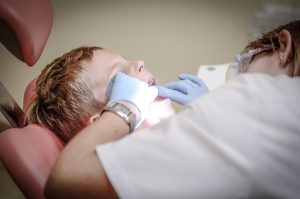More and more children are requiring dental work for tooth decay and other issues. In comparison to adults, they might be scared or apprehensive to sit on the dentist’s chair for these procedures. Imagine the anxiety a young child may get when the dentist needs to drill. This is why they undergo anesthesia or sedation – to ensure that they get safe and pain-free treatment.
Pediatric dentists have a choice between various types of sedation and anesthesia:

Mild Sedation
This kind of sedation is also used on adults during dentist procedures. It is safe and allows the dentist to do their work efficiently and without any distractions.
Moderate Sedation
This is used by dentists to make children sleepy and to keep their breathing normal. In most cases, the patient ends up not remembering the dental procedure performed on them.
Deep Sedation
This uses IV (intravenous medication) so that the child sleeps properly. During this state, kids may not breathe normally and may make noises. Thus, it is important that there is a professional around who will monitor the heart rate, oxygen saturation, blood pressure, heart rhythm, and breathing the entire time.
General Anesthesia
Used on both normal children and those with special needs, it is totally pain-free and puts the child to sleep. An anesthetist will administer it and will monitor the patient’s condition while the dentist is working on the child’s teeth. This is typically used in a better-equipped dental clinic or at a hospital.
Nitrous Oxide
This is more commonly known as laughing or giggle gas and is quite mild and less invasive. The patient stays awake but feels much more relaxed.
These drugs are administered in different ways, including oral, intravenous, through nasal inhalation, intramuscular, or subcutaneous. The choice of the method depends on the patient’s condition, the level of consciousness required by the dentist, and the procedure the dentist needs to perform.
Of course, the general health of the patient is taken into consideration, especially since sedation and anesthesia carry risks like airway obstruction, laryngospasm, or sleep apnea. There might also be side effects after the sedation and anesthesia itself, up to 24 hours after the procedure. This can include nerve damage, palsy of the facial nerve, fraction of the needle, and infections.

Questions to Ask Your Dentist
Parents might feel apprehensive about using sedation and anesthesia on their children, even if they know the dentist who is doing the procedure. To learn more about what to expect, you should ask your dentist these important questions.
- Before The Procedure
- Who will evaluate your child’s medical and dental state, which should include a comprehensive look into past dental and medical history?
- Should your child avoid drinking or eating a certain amount of time before the procedure?
- Will I need to give my child any medication at home prior to the appointment?
- What is the anesthetist’s experience, especially with children?
- Did the dentist undergo required and updated training on anesthesia and sedation, especially meeting all standards set by the authorities?
- Are staff members also trained and experienced in assisting with sedation, including doing emergency resuscitation procedures?
- During and After the Procedure
- What kind of sedation or anesthesia will be used on your child during this procedure? Besides the local anesthesia to numb the teeth and gums, will the sedation keep my child awake or unconscious?
- How will your child’s health be monitored during and after the procedure (either at the dental clinic or hospital)?
- What equipment and medications are on hand in case of any emergency?
- Will you receive instructions and contact information of medical experts in case of any complications after you get home? What should you watch out for, like fever, pain, or redness?
- Should your child avoid any food or drinks after the procedure, including avoiding physical activity?
Dental procedures can be scary enough for adults, which is why it is normal to think that children should be even more apprehensive or anxious. While sedation and anesthesia aim to make this experience more comfortable and easier for both patient and dentist, parents still need to be cautious before consenting to its use. By asking the right questions and getting all the information, they can better assess the situation and the capability of the dentist.




